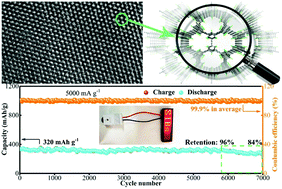Porous hydrogen substituted graphyne for high capacity and ultra-stable sodium ion storage†
Abstract
Graphyne and its derivatives, with a unique sp–sp2 hybridized structure and interesting electronic properties, are predicted to be attractive carbon materials for many practical applications. Here we report well-defined hydrogen substituted graphyne (HsGY) prepared using a facile bottom-up approach with a large area of up to 33 cm2. Studied directly by HRTEM, selected area electron diffraction and corresponding simulation, the as-synthesized crystalline HsGY nanosheets showed AB stacking with a lattice fringe of 0.445 nm. The aromatic C–H bonds and the acetylene linkages of HsGY provide a large number of active sites for ion binding; the high specific surface area, wide interlayer spacing, hierarchical porous structure, excellent electronic conductivity and low carrier barrier of HsGY also guarantee excellent intercalation and diffusion of sodium ions, making HsGY a promising anode for rechargeable batteries. Theoretical calculations demonstrate that the porous HsGY can provide numerous storage sites and deliver a theoretical capacity larger than 1207 mA h g−1. The prepared HsGY electrodes delivered a high reversible capacity of 600 mA h g−1 at a current density of 100 mA g−1; even at a high current density of 5000 mA g−1, the as-prepared HsGY electrodes can deliver a stabilized capacity of 320 mA h g−1 for 5900 cycles, with an excellent capacity retention of 96%.



 Please wait while we load your content...
Please wait while we load your content...